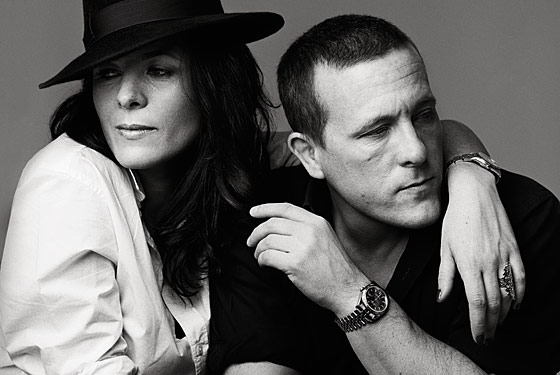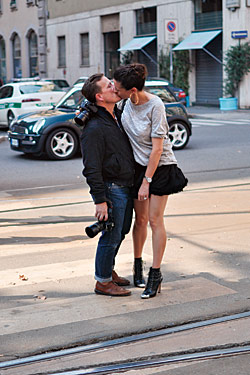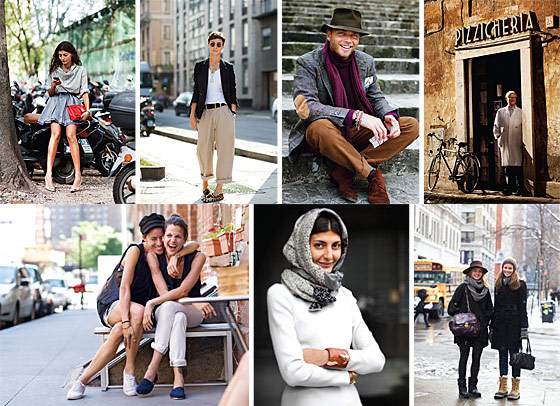
Scott Schuman (thesartorialist.blogspot.com) and Garance Doré (garancedore.fr) are fashion bloggers, and they are very much in love.
Last fall, they moved into a big, long apartment in the Village, the kind with one wall of exposed brick and two adjacent bedrooms in the back, one of which is for Schuman’s two young daughters from the marriage that ended not long before Doré began to appear on his website.
The first big thing the couple bought together was a Chesterfield sofa—brown leather, with lots of buttons—and they were sitting on it one afternoon, describing how they met at Paris Fashion Week. It was, Schuman says, four years ago.
“Can I tell the story?” Doré says. She is wearing a denim work shirt (his), navy-blue pants (“We bought them at Céline in Rome,” he says. “They look really great”), and ballet flats with a leopard print.
“Go ahead,” says Schuman. He is short and stocky, and he looks exactly like the former midwestern football player that he is. Something about him calls to mind the word leatherhead.
“I was a big fan,” says Doré. “Sometimes when I was looking at Scott’s pictures, I wanted to be with him. I wanted to be on his shoulder.” Doré looks at Schuman with a bit of a blush. “I don’t know if I ever said that to you. But it’s because of the light.”
She reluctantly tears her eyes away from her boyfriend. “I didn’t know his face or anything, but a friend of mine introduced me. She was like, ‘You’re going to meet Scott, but don’t bother, you know. He comes to Paris, and he wants to drink Starbucks.’ I was like, ‘Oh, yes. Bad American.’ ”
Schuman: “In the beginning it wasn’t a love thing.”
Doré: “Scott started having a crush on me. For me, it wasn’t a question: He was American! But very fast he changed my mind.”
Schuman: “Garance is very beautiful. And she has a great body. Which I had no idea at the time, by the way. She was very covered up.”
“In the beginning, I never thought my blog would be a success,” Doré continues. “I didn’t want other bloggers to be mad at me if I got too popular. It was my fake French modest side. Scott was the opposite of that. He helped me become more myself.”
“I hate to say it, but it wasn’t even super-sexual in the beginning,” Schuman says. “I was going through a divorce and stuff, but I just kept thinking, You’re going to be so great when you’re old. Here’s this beautiful young French girl, and I’m going, She’s going to be really great when she’s old. I grew up reading designers’ ideas about women, like: She’s so strong, she rules the world, whatever. I wouldn’t want to be with a girl like that, who’s type A. Garance is smart, driven, all these great Corsican qualities of self-determination, but she’s totally fragile. Totally insecure. That’s a real human. That’s the whole package.”
“I am very lucky,” says Doré.
The couple beams.
The world of who, exactly, makes the images that become our idea of “fashion” has, for a very long time, remained shockingly small. There are a few photographers who are on contract with several magazines, and they produce not only those magazines’ covers and editorials but also, more lucratively, the slick and shiny ads that appear between these pages. It’s been very close and very cozy for years.
But the Internet changed all of that, or some of it, and Schuman, 43, and Doré, 35, were there at the right moment, lingering outside (and, as time progressed, inside) fashion shows with their cameras around their necks. It’s not that the concept of street style was invented by these two—Bill Cunningham’s been at it forever—but they introduced the world to its latest commercial possibilities. If once upon a time the idea of “street” fashion suggested looks that were somewhat off the fashion grid, either in opposition to or in advance of the runway, Doré and Schuman are the opposite of that. “The thing that is really different from street style that came before is that it always seemed like they were trying to find the really different thing, find the crazy people and take a picture,” says Schuman. “I’d take a picture of a guy in a suit, and people would say, ‘That’s not street style,’ and I say, ‘But he was on the street!’ There’s much more subtlety on my blog than on other blogs.”
What Schuman and Doré do, in effect, is to remove one layer of fantasy from a typical editorial shoot. Their subjects still radiate glamour, but they are very rarely models. They are on Sixth Avenue or the Rue de Rivoli rather than in a stark-white studio.

Each had an early career on the fringes of the industry. Schuman, who “was probably one of the few straight young men in Indiana who read GQ and Vogue,” came to New York and worked in wholesale, eventually opening a small showroom where he represented designers like James Coviello and Peter Som. That business closed in the post-9/11 recession, and he decided to be a stay-at-home dad. He began photographing his kids. Then classes at ICP encouraged him to try more adventurous subjects (the Fulton Fish Market, a sassy Hasid, a pretty girl shopping at the Chelsea flea market), and he started posting his images every day.
Doré was raised in a “very wild” part of Corsica. There weren’t many roads, but one could still get a subscription to a fashion magazine. She grew up helping out at her parents’ restaurant (“It was very remote,” she says. “You had to get there by boat.” “But Agnelli went there!” Schuman is quick to point out. “Yes,” Doré says, “and my mother was always in the most outrageous Mugler”). Eventually, she made her way to Paris, where she found work as a freelance illustrator for fashion magazines. Her original reason for starting to blog was to give herself deadlines. She wanted to speed up her work. But then she started hanging out at the shows and taking pictures, and then there was Scott, who gave her a better camera, and now here she is describing a game of charades she’d played that weekend with Schuman’s 12-year-old daughter, Isabel.
Schuman’s blog caught the eye of the editors at men.style.com, who started sending him to Europe to cover the scene outside the shows. His scope began to widen. The subjects of his early posts are cute and stylish enough, but you can see him really falling in love with the people who wear high-fashion, in-season clothing. And his photography begins to improve, too. The quality of the light changes. Another change: He starts posting photographs of himself. One of the moody ones, a black-and-white of Schuman crossing the Place Vendôme in an unbuttoned trench, is credited to Doré.
Doré first appears on his blog in 2007, wearing khaki trousers, a Breton top, a fringed shawl, and a black jacket. The subject heading is “The Illustratoriste, Paris.” Later, she shows up in military shorts and stiletto heels under the heading “Garance just shops in my closet (and by ‘in my closet’ I mean the green shorts, not the heels!).”
Gabriel Byrne hurries by on the street. “If he looked more cool, I would have shot him,” says Schuman.
In 2009, Schuman published a book of his work, and Doré sat next to him in a strapless cocktail dress at the Barneys-sponsored signing that September. They nuzzled. They were officially official, and they (and their relationship) had become online presences, every bit as important as their subjects. In this way, they were now the opposite of Bill Cunningham, so anonymous in his blue work jacket and khaki pants. He’d never dream of dressing like his subjects, of posting photographs of himself. The documentary Bill Cunningham New York, out next month, is revealing in part because it discloses just how little even his closest collaborators know about him.
Schuman and Doré are more of an open e-book. They refer to each other all the time on their sites: “Darling man” on Doré’s blog might be a link to Schuman’s blog, for example, and she recently wrote a whole entry on why Scott doesn’t like cowboy boots, and how he doesn’t think she should change her hair. “I like your hair the way it is,” he’d texted her. “Clean and fresh and healthy.” In an interview with French Elle about her beauty regimen, Doré said: “My weight loss coach, a.k.a. Scott, makes me eat muesli with fresh raspberries. He says they’re the best fruit in the world.” She also described the face massages he gives her at bedtime using a special oil from Kiehl’s.
“In the beginning, Garance was like a soldier,” says Anna Dello Russo, Japanese Vogue editor and a street-style legend because of her tendency to wear head-to-heel runway evening looks at ten in the morning. Doré would be “waiting outside in the snow, in the rain, in the cold. She always would say, ‘I feel so underdressed next to you,’ and I would say, ‘You should.’ Now if you see her, she’s beautiful. She maybe takes less pictures, but she dresses very feminine, very elegant.” The relationships Doré and Schuman have built with their subjects have paid off: Dello Russo has given Doré assignments for Japanese Vogue; Carine Roitfeld (the outgoing editor of French Vogue and another major Sartorialist subject) has commissioned work for her magazine. Sarah Rutson is the fashion director of Lane Crawford, an Asian luxury boutique. Schuman photographs her regularly, and ultimately photographed a campaign for the store, which bore similarities to a campaign he did in 2009 for Burberry called the Art of the Trench. Doré and Schuman are often involved in casting decisions for this sort of commercial work, whose effect is always to suggest that the subjects were found—trench coats and all—out in the wild.

The benefits go both ways. Schuman and Doré’s blogs have made a group of women—Dello Russo, Marie Claire’s Taylor Tomassi Hill, Italian Vogue’s Giovanni Battaglia—into online celebrities, which has changed their lives, too. Dello Russo, for example, has come out with a signature perfume. “In the beginning, I would say, ‘Why you want to make a picture of us?,’ ” she says. “And Scott said, ‘When I look at a fashion magazine, I don’t find anymore the look of fashion. I saw beautiful images, but not how you can put on a coat for life.’ And I would say, ‘This is very clever. In a magazine, the images are so high, they are so beautiful.’ They are talking about the dream, but they don’t have reference about how you do this for life. That’s why these blogs are a revolution.”
Another way of looking at it, of course, is that they are the perfect supplement to the editorial-advertising loop (especially when Schuman and Doré are not actually shooting ads), filling a crucial gap that went unidentified until after it was filled. Last year, for instance, there were some very beautiful camel-hair coats on the runway at Céline and elsewhere, and they kicked off a huge trend for camel that filled the racks at Barneys, Zara, and everywhere in between.
So Doré shoots three gorgeous women attending fashion shows in their camel coats (the real runway version), and Schuman shoots Doré shooting those gorgeous women, which means four thin and gorgeous ladies are captured working a trend as they go about their days.
And the fashion loop is complete.
Schuman is walking around Soho with his camera in hand. When the fashion shows are not on, he shoots every single day, typically in this neighborhood. He doesn’t take lots of pictures and edit later—he doesn’t bother taking a photograph at all if he doesn’t think there’s a serious chance it will be used, and so he often ends a session with only one or two photographs. It’s not a great day for fashion. The sky is low and gray, the streets are slushy and brown. Most people are bundled against the cold, having abandoned any pretense of peacocking. “In this kind of weather, guys are much easier to shoot,” he says. “Except for this whole urban-lumberjack thing. Garance calls it fat-guy clothes because all the fat fashion guys wear those clothes.” He likes the outfit on a tall, Lauren Hutton–type woman, but finds her mien unpleasant. “She doesn’t look very nice,” he says. His camera stays around his neck.
On Spring Street, Gabriel Byrne hurries past. His clothes are not unusual or exceptional, but he looks glamorous because, well, he is Gabriel Byrne and he has that fantastic Gabriel Byrne face. Also, his scarf is knotted nicely.
Schuman doesn’t flinch. “If he looked more cool, I would have shot him,” he says. “But he didn’t look that cool.” The same thing happened with Vincent Cassel a week before, he says. Schuman doesn’t really care much for celebrities in general. When he photographed Chloë Sevigny in the Tuileries after a Chloé show, he didn’t I.D. her on his site. The photo, presumably, was about her thick, knit minidress. When he photographed a model riding bikes in Paris with Adrian Grenier, he labeled the photo “Isabel and friend.”
On Mercer Street, a tall, handsome guy in jeans, a crew-neck sweater, a down vest, and a pair of horn-rimmed glasses walks by, and Schuman stops. “Do you mind if I take your picture?” There is nothing revolutionary about this guy’s look, but it’s certainly successful: Everything fits nicely. His smile is sweet. The whole interaction takes about two minutes, and then Schuman turns the corner onto Prince Street.
See Also:
The Sartorialist’s Spawn